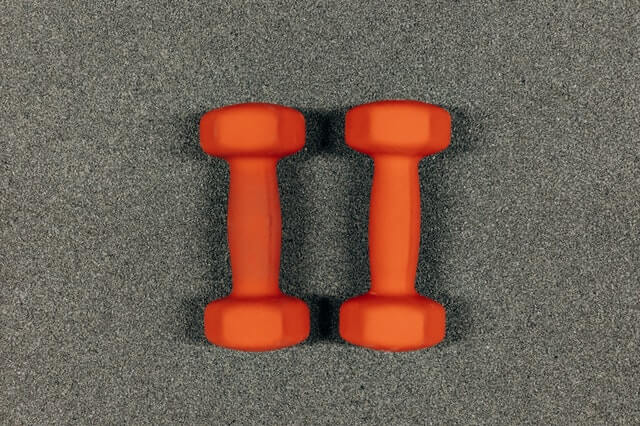Strength athletes and those who are physically active in particular swear by proteins to build their muscles. One or another amino acid has a key function in muscle growth.
Are the connections really that simple? Which protein building blocks do muscles need for their growth? Is separate supplementation of muscle-building nutritional supplements necessary? Which amino acids are essential for building muscle and which combinations are suitable?
Our test also takes into account protein building blocks that promote muscle growth in the background. Learn more.
Building muscle mass as a complex process - the role of amino acids
We first want to understand muscle building processes and then determine the proportion of amino acids in them. At first glance, growth processes in the muscles seem easy to understand. We train and the muscles grow.
However, there are some misconceptions when it comes to muscle growth. Some ambitious athletes may imagine this as an increase in muscle fibers. However, as muscle grows, the number of muscle fibers remains the same.
Their increase through training has not yet been proven in humans. Obviously, it's worth going into a little more depth to understand muscle building. The anatomy of the muscles is crucial.

How muscles are built - the anatomy of muscles
When we look at cross-sectional drawings of muscles, one thing stands out: the muscle is not a homogeneous structure. It is divided into bundles of muscle fibers. Each bundle is made up of several muscle fibers. The muscle fibers themselves consist of so-called sarcomeres. A sarcomere forms the framework for other elements.
These are what make the contraction of a muscle possible. Another word for contraction is contraction. That is why these elements actin and myosin in the sarcomeres are called contractile. If we train the muscles , the cross-section of the muscle increases. This is possible in two different ways.
Do muscles grow or just get fatter?
What we mean by building muscle is an adaptive response. For example, if we lift weights in the gym, this creates a tensile stress on the muscles. Depending on the intensity of training and weight , the muscles are mechanically overloaded for that moment . The structures and order in the muscle tissue are disrupted.
The muscles try to adapt to this disruption. She prepares herself for future stresses. To do this, she uses a subsequent regeneration phase. Then it forms new sarcomeres. Their number will increase overall. In this way, the cross-section of the individual muscle fibers increases. This process of change is referred to as parallel hypertrophy .
Hypertrophy means growth or thickening. The process is called parallel because new sarcomeres are built parallel to the existing ones.
Muscle structures do not always reproduce themselves
The change process does not affect the sarcomeres in every growth process. If a muscle is exhausted during training, more glycogen is formed in it. This is a storage form of carbohydrates. We know that carbohydrates are the primary energy source among nutrients. After a heavy load, the muscle stores more energy.
Glycogen binds three times as much water. There are 3 g of water for every 1 g of glycogen. This accumulation of fluid causes the volume in the muscles to change. This also leads to an enlargement of the cross section and thus to muscle growth for us . This type of muscle growth is called sarcoplasmic hypertrophy.
No training-related increase in muscle fibers?
Researchers have not yet been able to scientifically prove an increase in muscle fibers - hyperplasia - in humans. In contrast , studies have shown processes of hyperplasia in various animal species such as birds, cats and mice.
It is debatable whether we can extrapolate these results from animal studies to humans. What remains striking is that extremely trained bodybuilders often have more muscle fibers than untrained people.
At the moment, experts cannot yet decide whether this increase in muscle fibers is genetically determined from the outset or whether it arose from an increase in muscle fibers. As long as there is no scientific evidence of muscle fibers being created subsequently, hyperplasia plays no role in muscle building .
The special metabolism in the muscles
In order to better understand the overall function of the muscle and its growth , it is also worth taking a look at the metabolism. This is about the question of how energy is provided in the muscles. Muscles are constantly challenged in everyday life without any special training. Every movement uses a certain part of the muscles.
Every muscle performance is only possible through the energy provided. ATP is the main energy source in the muscle cells. This abbreviation means the name adenotriphosphate. Muscle cells are generally under a lot of strain . Supplies of ATP must be replenished in the shortest possible time.
Otherwise there would be no energy available for muscle performance. To do this, the muscle needs glucose (sugar). The sugar is converted into lactate so that ATP is available. If there is not enough glucose available, the muscles convert the body's own proteins . In a complex conversion process, broken down proteins ultimately produce glucose again for the formation of ATP.
Creatine has a special function in providing energy and forming ATP. This substance is formed from various substances and stored in the muscles.
Growth at rest, not during activity
We conclude the section on the anatomical and physiological requirements for muscle growth with a note : Muscles do not increase their cross-section during physical activity.
That's why it's so important that active phases and rest phases alternate. The development work takes place in the regeneration phase. Regardless of all other requirements, we hinder muscle building processes if we do not give our muscles enough time to regenerate.

Protein as a building material
Of the three macronutrients: carbohydrates, fats and proteins, protein is the most versatile element. In its various forms, it takes part in countless processes in the human body. The focus here is on amino acids as the smallest building blocks of proteins. The so-called proteinogenic aminos are indispensable as building materials for the body's cells.
Every physical tissue is made of protein in one form or another. If you want more muscle mass, you have to pay attention to the amino acid profile in your diet . Without proteins there is no muscle growth. What else should you know about aminos?
The role of essential aminos
The human organism can form a whole range of protein building blocks from other aminos and accompanying substances. This does not apply to eight protein building blocks. They have to be added to the diet again and again.
The following amino acids are essential:
- Tryptophan
- Threonine
- Valine
- Phenylalanine
- Methionine
- Lysine
- Isoleucine
- Leucine
Histidine and arginine are only essential in certain phases of life. They are therefore grouped together as a separate group under the heading semi-essential amino acids .
We need the essential building blocks for a wide variety of physical functions. Among other things, we need them to form other aminos. For example, the building block tyrosine is formed from phenylalanine.
The distinction between aminos as essential and non-essential does not make any statement about the importance of the individual building block for the human organism. Various non-essential amino acids are just as important to humans as essential types.
There is another interesting aspect about the essential representatives of the aminos: the amino acid profile from these building blocks is particularly easy for humans to use in its entirety. The amino acids can be optimally incorporated into body tissue and converted into other substances.
Amino acids muscle building test: protein building blocks with special properties
Tests and studies show that we can benefit more from some aminos than others in muscle-building activities. That's why we'll take a closer look at these building blocks. They are often components of special sports drinks, building powders and nutritional supplements for building muscle .
Above all, we will look at whether the general assumptions and statements about the effects of these proteins keep what they promise. Here we will also see how different building blocks work together. Our test will make it clear that isolated intake of certain amino acids in high doses is not always the best choice.
At first glance, some aminos seem to be of little importance for muscle growth. In the background, however, they have crucial functions. We would like to highlight that too.
BCAAs: Amino acids muscle building test
Almost every physically active person knows BCAA's. The abbreviation hides three essential aminos - leucine, isoleucine and valine . The English name Branched-Chain Amino Acids describes the interesting biochemical structure of these protein building blocks. The German word " branched chain " describes in a complex way amino chains that branch out in a peculiar way.
It is not uncommon for bodybuilders and endurance athletes to regularly consume sports drinks and dietary supplements containing BCAAs . They expect this to increase their performance and increase muscle growth. In the background are isolated study results that describe performance-enhancing effects for branched-chain amino acids .
A study shows that the time until fatigue can be extended using BCAA. This means that test subjects showed in the study that they were able to train longer after taking these aminos .
The time until exhaustion was reached could be delayed by 17%. It is still unclear whether this is a general performance-enhancing effect of leucine, isoleucine and valine.
There are still unanswered questions about BCAAs when it comes to muscle growth.
Scientists were able to prove that the three special aminos activate certain enzymes that play a role in building muscles.
High doses of the branched-chain building blocks have recently come under criticism. There is some talk here of health impairments and an increase in the risk of cancer.
It is therefore currently not certain whether reputable experts can in good conscience recommend taking BCAAs in high doses. The possible positive effects on muscle growth and performance are not clear enough. Too uncertain possible health effects at high doses.
Nevertheless , leucine, isoleucine and valine are essential aminos for the human organism. So let's take a look at each one again.

Leucine
Leucine takes part in a variety of functions and conversion processes. Among other things, it is important for the formation of glutamine. This non-essential amino plays a key role in various processes in muscle cells. We will look at this in more detail in a subsequent section.
Glutamine is needed, among other things, for the formation of glycogen, the carbohydrate stores we already know in muscle cells. We have already seen that an increase in the cross-section of the muscles can also result from more glycogen.
Therefore, we recognize at this point that leucine is involved in these complex processes . It is involved in the development of muscles through various conversion processes.
Isoleucine
This essential building block from the BCAA group is also involved in glutamine formation. He also takes part in various processes that have to do with ammonia metabolism and liver detoxification, among other things.
It is also converted into other proteins that, among other things, strengthen our immune system. Through these involvements in a wide variety of processes, isoleucine is involved in muscle building activities and in maintaining general performance .
Valine
Valine also plays a role as the third branched-chain amino in muscle metabolism . It forms part of the protein reserves in the body. These are used to generate energy when there is not enough glucose available.
These protein reserves are the first to be attacked when we starve or follow a calorie-restricted diet. Even during prolonged exertion, additional energy can be provided for the muscles.
BCAA's are important
Even if the branched-chain aminos are not a muscle-building miracle - as some advertising promises - we need them. Not least for muscle growth and the provision of energy in the cells.
This does not mean that we have to rely on high doses of isolated BCAAs to gain muscle mass . The possible uncertainties about health damage and side effects are also worth noting here.
Overall , valine, isoleucine and leucine should be part of a protein-rich, balanced diet. They can be contained in dietary supplements in combination with other protein building blocks.
We will see when looking at various other amino acids that it is often the combination of amino acids that makes the difference . A sensible and well-thought-out combination of amino acid profiles is more likely to lead us to more muscle mass than isolated products of individual amino acids.
Arginine
We'll follow up our discussion of arginine with BCAAs. In fact, we have a particular fondness for this amino. The non-essential building block is formed by the human organism itself in most phases of life. It is only semi-essential for us during childhood and adolescence. Why is arginine of particular interest to us ?
The amino is involved in special processes in the body that affect our performance and muscle building.
Scientists are excited about this building block.
Among other things, they were able to show that he ...
- can increase physical performance by 20% .
- Releases growth hormones and thus promotes muscle building .
How do arginine cause these effects?
What does arginine do?
To put a very complex process simply: arginine dilates the blood vessels. It stores and forms nitrogen. It thus contributes to a variety of conversion processes into other important proteins. Among other things, arginine is a precursor to creatine.
Arginine also influences the oxygen supply, for example in muscle cells, by widening the vessels. With enough arginine we absorb more oxygen because the respiratory and bronchial muscles relax.
arginine and nitrogen
Arginine lowers blood pressure. The nitric oxide formed by arginine helps, among other things, to distribute nutrients in the muscle cells. As a basis for collagen and connective tissue, this amino also contributes to the incorporation of proteins into body tissue. It is also involved in the formation of important enzymes.
Without enzymes, many reactions and processes in the human organism are not possible. We don't want to anticipate the result of our test of aminos for muscle growth : Arginine won a favorite position for us early on. None of the amino acids we have considered is as deeply involved in the entire muscle building process as arginine.
Although we don't generally expect miracles from amino acids, arginine has the most potential to do so. This is shown by many scientific tests and studies.

Amino acid muscle building test: creatine
Creatine is not an amino in the strict sense. We will treat the substance here after arginine, because arginine, methionine and glycine form creatine . Creatine plays a key role in muscle contraction, brain and nerve functions. It is involved in the provision of energy via ATP.
Due to this importance in the energy supply, the human body stores creatine as an energy source and energy precursor. How important the substance is for muscle functions is shown by congenital genetic defects in creatine production.
This leads to, among other things, pathological muscular disorders, weakly developed muscles and many other disabilities. The substance is therefore now considered essential for the function and development of all physical organs. Creatine is dependent on vitamin B12 in the formation.
Some scientific studies show that additional intake of creatine can have a positive effect on muscle metabolism. Delayed fatigue is particularly noteworthy here. This influences endurance performance during physical exertion and thus muscle growth.
Further testing and studies are needed to demonstrate the full potential of creatine as a possible dietary supplement for increased muscle growth.
7 amino acids for muscle building tested
This section deals with various other building blocks that are involved in the entire metabolic processes surrounding muscle growth. Some of them are essential, others are not. We treat each of them individually in our test because muscle growth as a whole would not be possible or effective without them.
They belong to the group of muscle-building aminos and vital substances. We dedicate small sections to them in order to make one thing clear once again: it's not just a single amino that is crucial for building muscles. Many building blocks are involved in the processes that ultimately lead to muscle building.
The test also clearly showed us this. Amino acids are connected to each other. If a single one is missing, it quickly becomes noticeable during physical exertion and when building muscles.
1. Lysine
Lysine is an essential amino acid. It has important tasks in building collagen connective tissue. It also stimulates cell division. Various enzymes, entire growth and the immune system depend on lysine. In connection with muscle building activities, lysine is said to optimize the training effects, among other things.
Further scientific confirmation is necessary here. The following is certain: The two contractile elements actin and myosin consist partly of lysine. In this article we have already learned what role these structures play in the growth of muscles .
2. Tyrosine
The human organism produces tyrosine from phenylalanine. This amino will not directly affect muscle growth. However, it strengthens mental focus during sporting activity and reduces stress .
It can therefore influence and strengthen physical performance. Those who can focus better during training will train more intensively and with greater concentration. This also benefits the growth of the muscles.
3. Glutamine
Glutamine is produced in the human organism. It is an important building block in muscle metabolism and therefore has an influence on muscle building.
We have already learned here that glutamine is associated, among other things, with the buildup of glycogen stores in the muscle. Individual studies show performance-enhancing effects and improved muscle growth through more glutamine. However, the overall study situation is controversial.
4. Glycine
The amino acid glycine has some special features. It is the first amino that researchers have detected in isolation. It also became famous when it was detected on a comet in space in 2004. Quite a few experts therefore refer to glycine as the original amino.
One property stands out in connection with sporting activities and muscle building processes: glycine can be converted into glucose. This amino is therefore an energy reserve. The building block is also integrated into a wide variety of body functions . It is involved in collagen formation. It also plays a role in the human nervous system.

5. Ornithine
This amino is formed from arginine. It plays an indirect role in muscle growth because it produces citrulline. It also influences immune function and can thus improve our performance.
6. Citrulline
Citrulline is particularly valued by bodybuilders. The building block can ensure increased blood flow and thus improve pump performance. Whether additional intake of citrulline via a dietary supplement makes sense in this context has not yet been clearly scientifically proven.
We don't leave the building block unmentioned in our test because many nutritional supplements for athletes are offered in the combination of citrulline-malate. Malate is a salt that is combined with citrulline.
7. Methionine
The essential building block methionine should not be missing from any contribution to amino acids. It is one of the few sulfur-containing amino acid proteins. The building block is involved, among other things, in the formation of creatine, taurine and carnitine. All three substances are linked to physical performance, including muscle building .
Methionine is one of the amino acids that have an intensive background effect on muscle growth. Its function is not as pronounced here as with arginine. But methionine is important for protein supply not only because of its essential nature . If you want to build muscle, you should also keep an eye on this amino acid.
Other vital substances for building muscle
There are a number of other substances and vital substances that can contribute to muscle growth. These are not protein building blocks or other aminos. Some of them require protein building blocks for their formation. They enrich and complement the amino acid profile when building muscle.
We briefly summarize them in a separate section:
- Taurine - this substance is active in various processes, especially in the cells. This also affects muscle cells. Here, taurine can, among other things, support the contraction of muscles. As a powerful antioxidant, taurine also generally supports physical performance.
- Carnitine - this ammonium compound is formed from lysine and methionine. The human organism needs carnitine for energy metabolism in the cells. Here it influences performance and the development of muscle mass.
- Various vitamins - In particular, vitamins from the vitamin B family are essential for muscle growth. Vitamin B1, vitamin B6 and vitamin B12 play a particular role here. Vitamin E and vitamin B are also necessary for overall energy metabolism and various regenerative processes in structures of the musculoskeletal system.
- Minerals and trace elements such as iron, magnesium, calcium and potassium should not go unmentioned when we talk about muscle growth and athletic performance. They are involved in metabolic processes, the building of tissues and structures and many other functions.
Use protein building blocks correctly
There are many detailed articles on athlete sites and product descriptions that cover the use of nutritional supplements for muscle growth. We will not delve into this aspect in our article. However, we would like to briefly mention a few factors. Recently there has been an increasing number of critical voices when it comes to high doses and isolated aminos for athletes.
This applies, for example, to BCAAs. The main problem when administering isolated products is the correct dosage and, in some cases, the correct time for intake. There are generally no scientifically proven recommendations in this area.
In studies, scientists sometimes use high dosages that cannot provide guidance for athletes in everyday life when taking nutritional supplements. Dosages that are too high could lead to side effects. The risks of too high doses and isolated amino acids have not currently been fully researched.
A certain exception here is arginine . Since the amino acid is also used in the medical field, there are dosage recommendations to a certain extent.
dosage
As a rule, there are no standardized dosage recommendations for the aminos we have mentioned here. There is also no clear requirement for some aminos. For arginine, the dosage recommendations for increasing performance are between 1000 and 2000 mg. To build muscle, daily values are 2000-5000 mg.

Time frame for recording
When using aminos in nutritional supplements, the time at which they are taken may also be important in individual cases. Here you should pay attention to the recommendations for individual building blocks. Sometimes it is recommended to take it on an empty stomach before training.
Side effects of performance and building-promoting amino acids
We absorb aminos every day through protein-containing foods. Usually these substances have no side effects. Side effects and interactions can arise if we additionally consume isolated amino acids in high doses. Many questions remain unanswered at the moment. Further tests and studies are necessary to gain clarity.
We are primarily aware of the potential dangers of muscle-building substances when it comes to substances that contain hormones, for example. Many such muscle building preparations are now banned. Even with such important and indispensable substances as aminos, it cannot be ruled out that they can harm us in excessive doses.
Amino acid muscle building test: Our first choice is arginine
We think it's difficult to make a consistent decision : all of the amino acids we mentioned for building muscle passed our test. Every single amino has its place and function in muscle growth. If we have to choose a favorite, we'll go with arginine. This protein building block has already been researched quite reliably.
In our opinion, it currently has the most demonstrable positive effects for everything that is associated with muscle growth in the human organism. Building muscles is a complex process . Arginine is active in various places here.
Finally, we would like to emphasize once again : An increase in muscle mass is also not possible without the other aminos and substances mentioned. If you pay attention to a well-thought-out composition of your amino acid profile, you will benefit from it when building muscles. The combination brings success - mainly in the long term.



